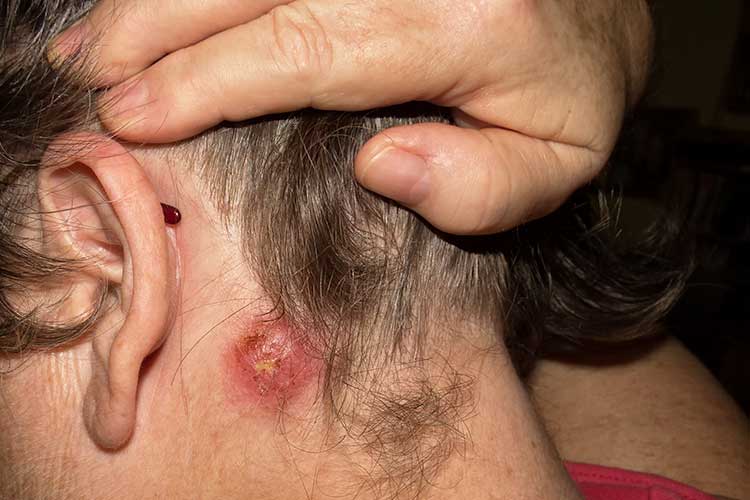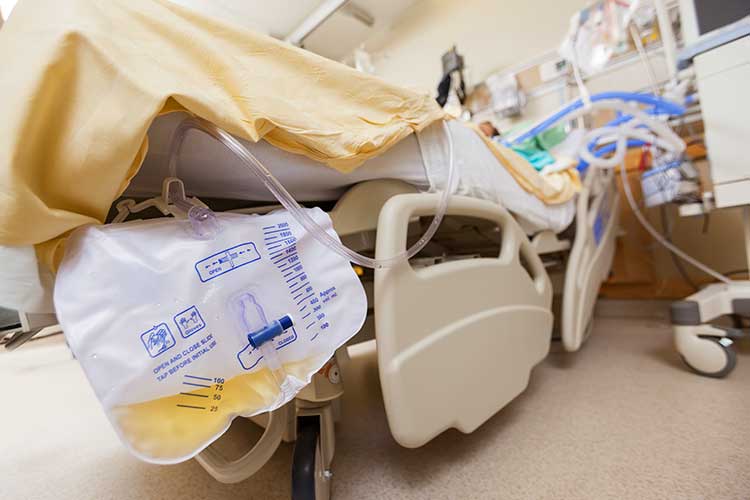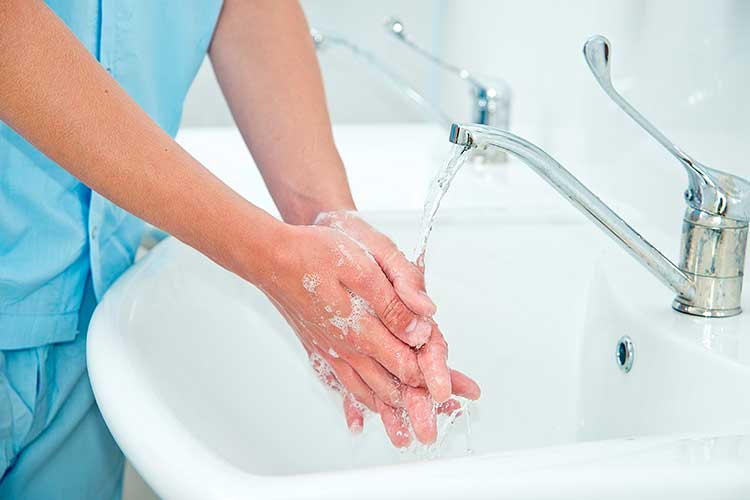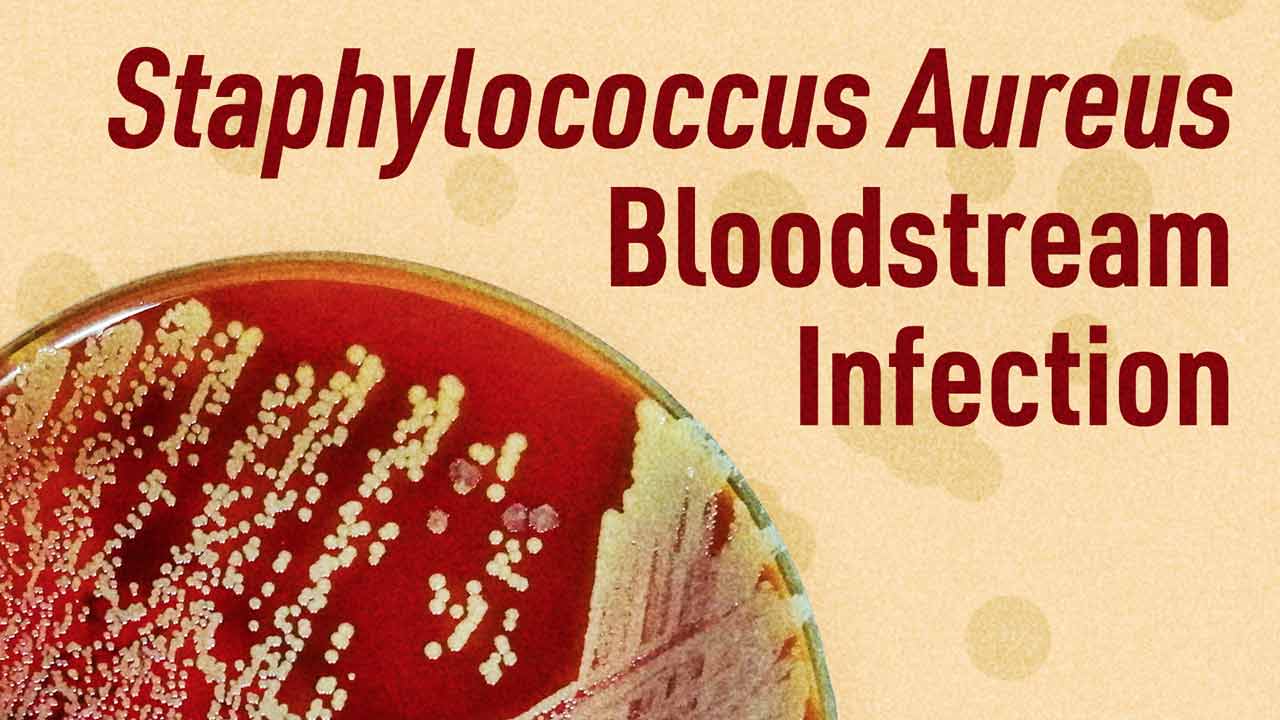Staphylococcus aureus bloodstream infection (SABSI) contributes to significant morbidity and mortality. Despite this, healthcare-associated SABSI is potentially preventable (ACSQHC 2021a).
What is Staphylococcus Aureus?
Staphylococcus aureus (also known as S. aureus or golden staph) is one of around 40 species of Staphylococcus bacteria (RCHM 2018).
S. aureus are carried by approximately 20% of the population at any given time, with about 60% of people being colonised off and on during their lifetime (SA Health 2022).
S. aureus commonly inhabit the inside of the nose as well as the skin, where they are usually harmless and unnoticeable. However, if they are able to enter the bloodstream, they may multiply and cause SABSI (AIHW 2023).
Infection may be caused by bacteria from the patient’s own body or via the transmission of bacteria from another person (Mayo Clinic 2022a).
Types of Staphylococcus Aureus Infections
S. aureus infections range from mild to severe and may be life-threatening (Mayo Clinic 2022a).
In some cases, S. aureus can colonise food, leading to food poisoning (SA Health 2022).
Most S. aureus infections affect the skin (Healthdirect 2023a). These infections, known as staph skin infections, are often transmitted through skin-to-skin contact, touching contaminated objects or sharing items such as clothes and towels (Queensland Government 2017).
Staph skin infections include boils and abscesses, staphylococcal scalded skin syndrome (SSSS), impetigo, cellulitis and wound infections (Healthdirect 2023b; Better Health Channel 2015).

Staphylococcus Aureus Bloodstream Infection (SABSI)
Staphylococcus aureus bloodstream infection (SABSI) occurs when S. aureus enters the bloodstream (AIHW 2023).
SABSI is a severe infection that may cause:
- Pneumonia
- Septic arthritis
- Sepsis
- Meningitis
- Osteomyelitis (infection in the bone)
- Toxic shock syndrome
- Endocarditis (infection of valves in the heart)
- Septic phlebitis (infection of a vein).
(Healthdirect 2023a; Better Health Channel 2015)
SABSI and other healthcare-associated infections are associated with complications such as prolonged hospital stays, increased healthcare costs and even death in the most serious cases (Monegro et al. 2023).
How Does a Staphylococcus Aureus Bloodstream Infection Occur?
In healthcare settings, most cases of SABSI are related to poor hand hygiene among staff, invasive devices and healthcare procedures (ACSQHC 2021a).
S. aureus may be transmitted via contact with patients who have discharging wounds or infections or are colonised with the bacteria. If a staff member’s hands become contaminated with S. aureus, the bacteria may then be able to enter the bloodstream through open wounds, incisions or invasive devices (AIHW 2021; Health.vic 2015).
Someone who becomes colonised with S. aureus will not necessarily develop an infection, but if they do, this could occur from days to years after the initial exposure. However, even if someone is asymptomatic, they are infectious as long as S. aureus is being carried on their skin (SA Health 2022).
Healthcare-Acquired Staphylococcus Aureus Bloodstream Infection
A SABSI is considered to be healthcare-associated (HA-SABSI) if either:
- An initial positive blood culture is taken more than 48 hours after admission (with no evidence the infection was present upon admission) or within 48 hours after discharge, OR
- An initial positive blood culture is taken 48 hours or less after admission, AND:
- The infection is the result of an invasive device complication, or
- The infection occurred within 30 days of a surgical procedure and is related to the surgical site (90 days for deep incisional/organ space infections related to a surgically implanted device), or
- The infection was diagnosed within 48 hours of an invasive instrumentation or incision that is related to the infection, or
- The infection is related to neutropenia contributed to by cytotoxic therapy.
(ACSQHC 2021b)
If the infection does not meet these criteria, it is considered to be community-acquired (ACSQHC 2021b).
Methicillin-resistant Staphylococcus Aureus (MRSA) Infection
Over time, several strains of S. aureus have developed antibiotic resistance to certain medicines, including penicillin, methicillin and vancomycin (Better Health Channel 2015). These strains, known as methicillin-resistant Staphylococcus aureus (MRSA), are difficult to treat as fewer types of antibiotics will work effectively (Mayo Clinic 2022b).
For this reason, MRSA strains are associated with poorer patient outcomes (AIHW 2021).
MRSA strains can be acquired in both healthcare settings and community settings. Community-acquired cases of MRSA are known as community-associated methicillin-resistant Staphylococcus aureus (CA-MRSA) (WA DoH 2019).
Risk Factors for Staphylococcus Aureus Bloodstream Infection

These include:
- A weakened immune system (due to cancer or a transplant)
- Age (being very young or an older adult)
- Chronic illness (e.g. diabetes)
- Open wounds
- Having an invasive medical device in situ (e.g catheter)
- Prolonged antibiotic use
- Sharing personal items (e.g. towels, razors)
- Stays in healthcare settings (e.g. hospitals, residential aged care)
- Use of injection medicines (e.g. opioids)
- Outpatient surgeries and procedures (e.g. dialysis).
(Healthdirect 2023a; CDC 2019)
Treating Staphylococcus Aureus Bloodstream Infection
SABSI is generally treated with intravenous antibiotics upon diagnosis (SA Health 2022).
Preventing Staphylococcus Aureus Bloodstream Infection
Effective hygiene measures are essential in preventing the transmission of S. aureus and other healthcare-associated infections (Healthdirect 2023c). Healthcare workers should ensure they:
- Follow hand hygiene practices, especially after touching wounds or wound dressings
- Don appropriate PPE when required
- Handle used equipment and laundry carefully
- Isolate infected patients if required
- Clean all surfaces thoroughly.
(Better Health Channel 2015; SA Health 2022)

Antibiotics must be used responsibly in order to reduce the risk of new resistant strains of S. aureus. Ensure that common, narrow-spectrum antibiotics are prescribed whenever possible (Better Health Channel 2015; Health.vic 2015).
Read: Appropriate Antibiotic use in Aged Care
Other ways to prevent the spread of S. aureus include:
- Ensuring patients’ wounds are appropriately covered in order to prevent S. aureus from entering the bloodstream
- Ensuring patients’ staph skin infections (e.g. boils and infected wounds) are appropriately covered to prevent exposure to pus or drainage
- Immediately disposing of used wound dressings in a sealed plastic bag
- Washing the clothes, towels and sheets of an infected patient with detergent and hot water, then drying them in sunlight or using the hot setting of a clothes dryer
- Ensuring that personal items (e.g. towels, razors) are not shared between patients
- Taking additional precautions when treating patients with an MRSA strain (e.g. allocating them a single room with ensuite facilities).
(Better Health Channel 2015; SA Health 2022)
Surveillance of Healthcare-Associated Staphylococcus Aureus Bloodstream Infection
Surveillance refers to the monitoring and reporting of healthcare-associated infections in order to identify possible risk prevention strategies (VICNISS 2024).
In Australia, all cases of SABSI in acute public hospitals must be monitored and reported by their relevant jurisdictions (ACSQHC 2021).
When testing for SABSI, two sets of blood cultures should be taken from two different venepuncture sites. If these results don’t match, further investigation is required (ACSQHC 2021).
When a SABSI case is identified, an assessment should occur in order to determine whether the case meets the definition of a healthcare-acquired infection (see above) (ACSQHC 2021).
Test Your Knowledge
Question 1 of 3
True or false: A person can be colonised with Staphylococcus aureus without experiencing symptoms.
Topics
References
- Australian Commission on Safety and Quality in Health Care 2021a, How to Analyse Staphylococcus Aureus Bloodstream Infection (SABSI) Data for Quality Improvement, Australian Government, viewed 28 February 2024, https://www.safetyandquality.gov.au/sites/default/files/2021-01/sabsi_analysis_information_sheet_-_data_for_quality_improvement_0.pdf
- Australian Commission on Safety and Quality in Health Care 2021b, Implementation Guide for the Surveillance of Staphylococcus Aureus Bloodstream Infection, Australian Government, viewed 28 February 2024, https://www.safetyandquality.gov.au/publications-and-resources/resource-library/implementation-guide-surveillance-staphylococcus-aureus-bloodstream-infection
- Australian Institute of Health and Welfare 2023, Admitted Patient Safety and Quality, Australian Government, viewed 28 February 2024, https://www.aihw.gov.au/reports-data/myhospitals/intersection/quality/apc
- Australian Institute of Health and Welfare 2021, Bloodstream Infections Associated with Hospital Care 2019–20, Australian Government, viewed 28 February 2024, https://www.aihw.gov.au/reports/health-care-quality-performance/bloodstream-infections-associated-with-hospital-ca/contents/about
- Better Health Channel 2015, Staphylococcus Aureus - Golden Staph, Victoria State Government, viewed 28 February 2024, https://www.betterhealth.vic.gov.au/health/conditionsandtreatments/staphylococcus-aureus-golden-staph
- Centers for Disease Control and Prevention 2019, Data Visualization: Take Action Against All Staph, U.S. Department of Health & Human Services, viewed 28 February 2024,https://www.cdc.gov/vitalsigns/staph/data-visualization.html
- Healthdirect 2023a, Invasive Staph Infections, Australian Government, viewed 28 February 2024, https://www.healthdirect.gov.au/invasive-staph-infections
- Healthdirect 2023c, Staph Infections, Australian Government, viewed 1 March 2024, https://www.healthdirect.gov.au/staph-infections
- Healthdirect 2023b, Staph Skin Infection, Australian Government, viewed 28 February 2024, https://www.healthdirect.gov.au/staph-skin-infection
- Mayo Clinic 2022b, MRSA Infection, Mayo Clinic, viewed 28 February 2024, https://www.mayoclinic.org/diseases-conditions/mrsa/symptoms-causes/syc-20375336
- Mayo Clinic 2022a, Staph Infections, Mayo Clinic, viewed 28 February 2024, https://www.mayoclinic.org/diseases-conditions/staph-infections/symptoms-causes/syc-20356221
- Monegro, AF, Muppidi, V & Regunath, H 2023, ‘Hospital-Acquired Infections’, StatPearls, viewed 28 February 2024, https://www.ncbi.nlm.nih.gov/books/NBK441857/
- Queensland Government 2017, Staphylococcus Aureus Infection, Queensland Government, viewed 28 February 2024, http://conditions.health.qld.gov.au/HealthCondition/condition/14/33/132/staphylococcus-aureus-infection
- The Royal Children's Hospital Melbourne 2018, Staphylococcal Infections, RCHM, viewed 28 February 2024, https://www.rch.org.au/kidsinfo/fact_sheets/staphylococcal_infections/
- SA Health 2022, Staphylococcus Aureus Including Methicillin-Resistant Staphylococcus Aureus (MRSA) - Including Symptoms, Treatment and Prevention, Government of South Australia, viewed 28 February 2024, https://www.sahealth.sa.gov.au/wps/wcm/connect/public+content/sa+health+internet/conditions/infectious+diseases/staphylococcus+aureus+including+methicillin-resistant+staphylococcus+aureus+mrsa/staphylococcus+aureus+including+methicillin-resistant+staphylococcus+aureus+mrsa+-+including+symptoms+treatment+and+prevention
- VICNISS 2024, What is Surveillance?, VICNISS, viewed 1 March 2024, https://www.vicniss.org.au/about/what-is-surveillance
- Western Australia Department of Health 2019, Management of CA-MRSA, Government of Western Australia, viewed 28 February 2024, https://www.health.wa.gov.au/Articles/J_M/Management-of-CA-MRSA
Additional Resources
- Implementation Guide for the Surveillance of Staphylococcus Aureus Bloodstream Infection | ACSQHC
- Appropriate Antibiotic use in Aged Care | Ausmed Article
- Donning and Doffing PPE Correctly | Ausmed Article
- Effective Surface and Environment Cleaning | Ausmed Article
- Hand Hygiene 101 | Ausmed Article
- Infectious Diseases: How Do You Break the Chain? | Ausmed Article
- Surveillance of Healthcare-Associated Infections | Ausmed Article
- Antimicrobial Resistance and Stewardship | Ausmed Course
 New
New 
